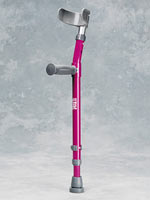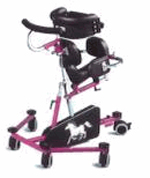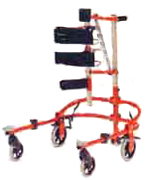Pediatric Walking Aids
Children's walking aids can be fairly basic canes, crutches, walkers or more complicated gait trainers. The level of complexity will depend on the child's abilities and the degree of help they will need to walk. Walkers are generally used for kids who can bear their own weight through their legs but have trouble with balance or moving their feet when standings. Generally speaking, gait trainers are used when the child has limited ability to bear their own weight and/or needs more upper body support and/or has yet to learn how to walk.
Canes
There are canes designed for children and they don't differ much from adult versions. The cane can have a single tip which touches the ground or it can be of the quad cane variety with four tips on the ground. The quad cane design is a little more stable for those with balance issues.
Crutches
Whereas with a cane, the weight of the user is supported through the arm or arms, with conventional crutches the weight is primarily supported by the under arm pads and the arms are used for control. The crutches are moved forward in unison while the user's weight is supported by one or both of their legs. Once the crutches are securely positioned forward the user will move their body forward through the crutches to the forward position.

Forearm Crutches
Forearm crutches are basically canes which extend up the arm and cup around the forearm. They allow for more support than a cane but are less supportive than a pair of conventional crutches. People who can use them will find them less cumbersome than conventional crutches.
There is a knack to using crutches that takes some practice to master. The company or organization who sell you your crutches should take some time to explain the use of them and some instruction from a health care professional would be in the best interest of the user.
Walkers

Pediatric walkers are generally height adjustable and can be either pulled from behind or pushed in from depending on their style and the child's abilities. They can have no wheels, two wheels or four wheels. The more wheels on a walker the less stable it is however the more wheels the easier it will be to move. Some types of walker wheels will swivel which eases turning but reduces the stability of the walker. The rear wheels, when four wheels are used, in some cases can have drag brakes which slow the rotation of the rear wheels to make the walker more controllable and stable for the child.
Children's walkers can also have forearm attachments (as pictured) which allow the child's weight to be transmitted down through the elbows and forearms to the walker. These attachments are helpful for kids who cannot grip the walker with their hands or support their weight through their hands.
Gait Trainers

Gait trainers are sometimes referred to as walking frames are are usually used to train kids who have never walked to walk or to re-train those who have lost the ability to walk due to an accident or medical event of some type. They are basically walkers which are designed to support a person so completely that there is no way they can fall down while positioned in or on the device. A user in a walking frame doesn't have to support their weight or be concerned with balance.
The information I'm posting about gait trainers is very generic as there are many differences in features and function from one model to another not to mention the fact that many gait trainers have extra optional features available in addition to the base unit. At the bottom of this page I've shown several versions of the more popular gait trainers with some basic information and links to more info.

Gait trainers tend to be quite expensive pieces of equipment and there are quite a large variety of products on the market. The features of the gait trainer the user will require will vary from person to person depending on their abilities. In addition to the user's abilities, another consideration when purchasing a walking frame is how much effort is required to load the user in it. When you're trying to help a person who can't walk, and probably can't stand, get into one of these pieces of equipment the ease of loading will be a major consideration.
More than any other piece of equipment, the aid and advice of a health care professional, such as a physio of occupational therapist is essential in choosing the best model of gait trainer for the user. This is not usually a major issue for most users as people who are candidates for walking frames are already receiving the services of these professionals.
Childrens Rehab Centres, Clinics & Hospitals
- British Columbia Children's Treatment Centres
- Alberta Children's Treatment Centres
- Saskatchewan Children's Treatment Centres
- Manitoba Children's Treatment Centres
- Ontario Children's Treatment Centres
- Quebec Children's Treatment Centres
- New Brunswick Children's Treatment Centres
- Prince Edward Island Treatment Centres
- Nova Scotia Treatment Centres
- Newfoundland & Labrador Treatment Centres


 Online Vendors
Online Vendors  US Online Vendors
US Online Vendors 